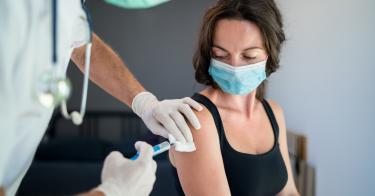So how are the COVID vaccination efforts going? The answer varies.
The success of the vaccine rollout hinges on three sets of actors, each with different responsibilities: the pharmaceutical companies manufacturing the vaccines; the federal government coordinating their distribution, and state public health officials managing the process for getting people vaccinated. Here’s an assessment of how they’re doing.
So far, manufacturing seems to be ramping-up as planned. Last summer, the Trump administration contracted to pre-purchase large quantities of promising vaccines before they gained FDA approval, with options to buy even more later. That enabled vaccine makers to better plan and build-out manufacturing capacity in advance.
Thus, when the FDA granted Emergency Use Authorizations for the Pfizer-BioNTech vaccine (Dec. 11) and Moderna’s vaccine (Dec. 18), those companies immediately began shipping product. They appear to be on track to meet their targets of delivering 100 million doses each by the end of March.
Also in December, the Trump administration exercised the government’s contract options to order an additional 100 million doses of each vaccine. The agreements for those second orders specify delivery by June, or “at the latest” by the end of July. The Biden administration announced last week that it intends to again exercise those contract options to obtain a further 100 million doses of each vaccine.
Thus, it is likely that the U.S. should have enough doses available to vaccinate the entire adult population before the end of 2021.
>>> I’m a Doctor. Here’s Why I Plan to Get the Coronavirus Vaccine.
Needs More Illumination: Distribution
Last fall, the federal government’s “Operation Warp Speed” set up the system for distributing vaccines to the states. As the manufacturers make and release vaccines, the federal government allocates doses based on each state’s share of the population. Each state then submits orders to “draw down” doses from its available allocation and have them shipped to the locations it specifies.
This is the part of the process where some problems have recently been reported.
States have complained that federal officials aren’t giving them enough advance notice for when and how much their allotments will be increasing – making it hard for them to incorporate supply projections into their vaccination plans. That complaint appears to have some merit, and federal officials have committed to giving states that information further in advance.
Beyond that, it’s difficult to determine the extent to which reported delays are due to problems at the federal level in arranging deliveries, versus some states just being slower in ordering and using their full allotments. HHS could provide more clarity by releasing data on the timing and size of state draw-downs, so that it can be compared with the data on deliveries to states that it has been posting.
Could Go Better: Vaccination
State vaccination efforts are the “last mile” of the process. To ensure things went smoothly, federal officials last September asked states to submit their plans for managing vaccinations.
As of the end of January, the federal government had distributed 49.9 million doses, of which 46.6 million went to the 50 states and Washington, D.C. The remainder went to U.S. territories and federal programs that provide direct patient care, such as the Veteran Health Administration. The states have so far administered 63 percent (29.2 million) of those 46.6 million doses.
In January, the median state vaccination rate (the percentage of doses delivered that have been administered) rose from 28 percent to 63 percent. However, there were significant performance gaps among the states. For instance, the daily vaccination rate for the largest state, California, remained below the median throughout January, while the rate for the second largest state, Texas, was consistently above the median.
Some state disparities were quite significant. For example, Virginia’s daily vaccination rate started the month at 25 percent and didn’t get consistently above 40 percent until January 24. Meanwhile, the daily vaccination rate in neighboring West Virginia was between 60 and 75 percent for most of January and above 75 percent during the last week of the month.
>>> All Signs Point to Vaccine Success Against COVID-19
West Virginia officials attribute their success to adopting a strategy of providing vaccinations at numerous sites that people already frequent, such as local pharmacies and schools. They viewed that approach as a better fit for their state’s geographically dispersed population, many of whom would otherwise have to drive to bigger towns to get vaccinated at a hospital or clinic.
Other states with vaccination rates consistently in the top half included: Colorado, Connecticut, Montana, New Mexico, North Dakota, Oklahoma, South Dakota and Vermont. Persistent laggards included: Alabama, Arizona, Hawaii, Idaho, Mississippi and Wisconsin. Basically, while almost all states increased their vaccination rates during January, the improvements made by these lagging states were not sufficient for them to catch up with their peers.
With manufacturing on track to deliver the necessary doses, and federal officials working to fix any distribution issues, the speed and effectiveness of the vaccine roll-out going forward will hinge primarily on the thoroughness and appropriateness of each state’s prior planning, and how effectively governors and state health officials implement their plans.
The good news? Despite the bumps on the road and differences in state performance, the U.S. currently ranks fourth (population adjusted) in the world in terms of getting shots into arms.
This piece originally appeared in RealClear Health




